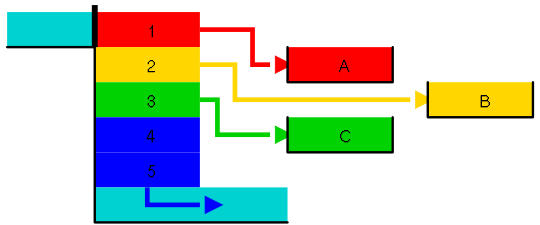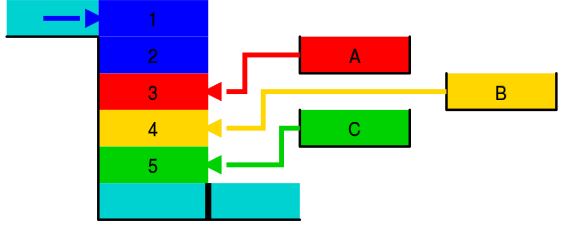Savings lock


An economy lock is a special lock design that can be used to reduce the water consumption per lock.
The problem of water consumption
A lock has to be completely filled with water each time it is locked in the mountain and emptied again each time it is locked in the valley. Normally, the required water is taken from the upper water and then drains into the lower water . This is not a problem with locks on rivers , where the flowing water itself provides a constant supply of water. If, for example, you want to cross a mountain range with a canal, at the apex of which there are no or only small natural tributaries, special measures are necessary, as otherwise the canal would gradually empty down into the valley.
Possible countermeasures
Possible measures to prevent the canal from falling dry are:
- Natural waters are "tapped" and fed into the canal at its apex. However, this is not possible everywhere and it can also cause ecological problems as there is then a lack of water elsewhere.
- Only as many ships may be locked as the natural flow of water allows. However, this limitation can significantly reduce the economics of the channel.
- After the valley lock, the water is pumped back into the upper water , which, however, requires a considerable amount of energy and also a certain amount of time.
- The use of ship lifts instead of locks, which is significantly more expensive, especially for larger ships.
- A part of the water is held back through the use of an economy sluice. This solution was implemented in 13 of the 16 steps of the Main-Danube Canal , for example .
How an economy lock works
In the case of an economy lock, there are additional water basins or chambers staggered in height in addition to the lock chamber. In a valley sluice - according to the physical principle of communicating pipes - these savings basins are first filled one after the other. Only the rest of the water runs down the valley. Conversely, in the case of mountain locks, the lock chamber is first filled with the water from the basin. Only the rest comes from the upper water. In contrast to pumping out the lock chamber, not the entire amount of water can be retained, but here the water runs “by itself” into the basin or back into the lock chamber due to the difference in height. You just have to open and close the shut-off devices at the right time (pumps can still be used to speed up the process).
The following picture shows schematically the function of an economy lock with three economy basins, each of which holds 20% of the lock chamber content. The light blue areas symbolize the upper and lower water.
- Functional principle of an economy lock
During the valley lock , basin A (red) is filled first, then basin B (yellow) and finally basin C (green). The part of the water marked in dark blue (areas 4 + 5) is drained into the underwater.
During mountain locks, the basins are emptied into the lock chamber in reverse order, i.e. first C, then B and finally A. The upper two fifths of the total volume (dark blue) then come from the upper water. In this way, only two fifths of the total chamber volume has to be fed in from above with each lock.
In the ideal case, the change in water consumption is calculated with n saving basins
The more pools there are, the greater the savings, but the higher the space requirements and construction costs. Often three basins are used per lock chamber, with which up to 60% of the water volume can be saved.
If space is limited, closed savings basins (savings chambers) can be selected, such as the Anderten double lock in the Mittelland Canal and the Minden shaft lock in the north connecting canal to the Weser. The savings chambers are located here in the widened lock chamber walls along the entire length of the chamber in several layers on top of each other with a saving of approx. 70% lock water.
Records
The three savings locks Hilpoltstein , Eckersmühlen and Leerstetten on the Main-Danube Canal have the highest drop of all locks built in Germany at 24.67 meters.
The savings sluices of the Panama Canal expansion project opened in 2015 - Agua Clara and Cocoli - are 425 m long and 55 m wide and are the largest in the world.
Picture gallery
Saving basin of the Hohenwarthe lock , 2004
Empty savings basin in the new lock in Waltrop lock park , 2008
The Niederfinow lock staircase , which was closed in 1972, was empty , in 2009
literature
- M. Eckoldt (Ed.), Rivers and Canals, The History of German Waterways, DSV-Verlag 1998
- The Mittelland Canal, Reich Ministry of Transport 1938
Web links
- Pumped storage plant Dürrloh - For the Rhine-Main-Danube Canal - the Dürrlohspeichersee receives the amount of water for 16 smuggling per day.
- Animation of the Federal Waterways and Shipping Administration
Individual evidence
- ↑ Main-Danube Canal - Ships drive over the mountain . As of October 10, 2009.
- ^ Autoridades del canal Panamá .





